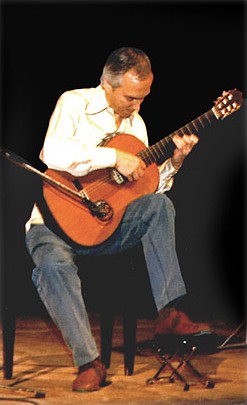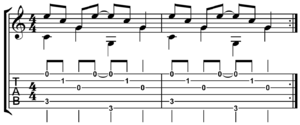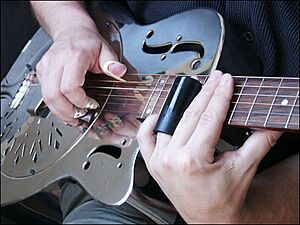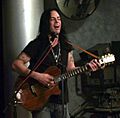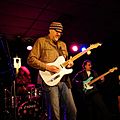Fingerstyle guitar facts for kids
Fingerstyle guitar is a way of playing the guitar or bass guitar by plucking the strings directly with your fingertips, fingernails, or special picks worn on your fingers. It's different from using a single flat pick (called a "plectrum").
The cool thing about fingerstyle is that you can play many different parts of a song at the same time. Imagine a band with a bass player, a rhythm guitarist, and a lead guitarist. With fingerstyle, one person can play all those parts on a single guitar! This means you can play the melody (the main tune), the chords (the harmony), and the deep bassline all at once. Sometimes, guitarists even tap on the guitar body to add drum-like sounds.
Fingerstyle is very common for classical guitars (which have nylon strings). It's also used on steel string guitars, but less often on electric guitars. When you play fingerstyle, the sound of each note can be softer and more like a piano than if you used a pick.
Contents
How Fingerstyle Works
Since each finger can pluck a string on its own, a fingerstyle guitarist can play several musical parts at the same time. Think of it like this:
- Your thumb can play the deep bass notes.
- Your other fingers (index, middle, ring) can play the chords and the melody.
- You can even add percussion by tapping the guitar body.
Many fingerstyle guitarists use a special thumbpick and keep their fingernails just right. This helps them get a clear sound and protects their nails. Famous guitarists like Ani DiFranco and Tommy Emmanuel use this method.
Good and Bad Sides of Fingerstyle
Fingerstyle has some cool advantages:
- You don't need to carry a pick! But you do need to keep your fingernails in good shape if you use them.
- You can play notes on strings that are far apart at the exact same time. This lets you play a low bass note and a high melody note together.
- It's great for playing solo, like a mini-orchestra on one guitar. You can play separate melody, harmony, and bass parts.
- It's easy to play arpeggios (where chord notes are played one after another).
- You can pluck up to five strings at once to play a full chord without strumming.
- You have more control over the sound and how loud or soft you play.
However, there are a few downsides:
- It's harder to play very fast, repeated notes (called tremolo) compared to using a pick.
- Playing on very thick strings can damage your nails if you don't use fingerpicks.
- Acoustic fingerstyle playing can sometimes be quieter than playing with a pick.
Fingerstyle on Nylon String Guitars
Nylon string guitars are usually played fingerstyle.
Classical Guitar Fingerstyle
Classical guitar playing is a type of fingerstyle used to play art music on nylon string guitars. It lets a single player perform complex harmony and polyphonic (many-voiced) music, much like a piano. This technique gives the player a lot of control over the sound, how notes are played, and the overall feel of the music.
Classical guitarists often sit in a specific way, usually with the guitar on their left leg, which is raised. This helps them keep their body balanced and their hands in the best position. They use their thumb, index, middle, and ring fingers to pluck the strings.
Finger Names in Classical Guitar
In classical guitar music, the fingers of your plucking hand (usually the right hand) are given special letters:
- p = thumb (from pulgar in Spanish)
- i = index finger (from índice)
- m = middle finger (from medio)
- a = ring finger (from anular)
- Sometimes c or x for the pinky finger (from chiquito).
The fingers of your fretting hand (usually the left hand) are just numbers: 1 (index), 2 (middle), 3 (ring), 4 (pinky). A 0 means an open string (not pressed down).
Alternating Fingers
To play fast and smoothly, classical guitarists practice "alternation." This means they try not to pluck the same string twice in a row with the same finger. Common patterns include:
- i–m–i–m: For playing melodies on the higher strings.
- a–m–i–a–m–i: For a rapid, repeating note effect (tremolo).
- p–i–p–i or p–m–p–m: For melodies on the lower strings.
Making Different Sounds
Classical guitarists can change the sound (or timbre) of their notes in many ways:
- Where they pluck the string (closer to the middle for a soft sound, closer to the bridge for a bright sound).
- Whether they use their fingernail, fingertip, or both. Most modern players use both the nail and fingertip for a controlled sound.
- The angle of their wrist and fingers.
- Using a "rest-stroke" (where the finger rests on the next string after plucking) or a "free-stroke" (where the finger doesn't rest).
Flamenco Guitar Fingerstyle

Flamenco guitar technique is similar to classical guitar but focuses more on rhythm and loudness. Flamenco guitarists often use special techniques like:
- Picado: Fast, single-note scales played with a strong attack.
- Rasgueado: A unique strumming technique where all the right-hand fingers flick out quickly, one after another, to create a rolling sound.
- Alzapua: A thumb technique where the thumb plays single notes and also strums across several strings very fast.
- Tremolo: Played differently from classical tremolo, often with the pattern p–i–a–m–i.
Bossa Nova
Bossa nova music is usually played on a nylon-string classical guitar using fingers. It often sounds like a single guitar and vocals, as made famous by João Gilberto. The guitar in bossa nova often plays a rhythm that sounds like a samba ensemble (a group of musicians playing Brazilian music).
North American Fingerstyle Traditions
Country Blues Fingerpicking
Fingerpicking (also called thumb picking or alternating bass) is both a playing style and a type of music. It's a kind of fingerstyle where the thumb keeps a steady rhythm, usually playing bass notes on the lower strings. At the same time, the index and middle fingers play melodies and fill-in notes on the higher strings.
This style started in the late 1800s and early 1900s. Southern blues guitarists wanted to sound like the popular ragtime piano music of the time. The guitarist's thumb acted like the pianist's left hand (playing bass), and the other fingers acted like the pianist's right hand (playing melody). Early blues players like Blind Blake and Mississippi John Hurt were masters of this style.
American Primitive Guitar
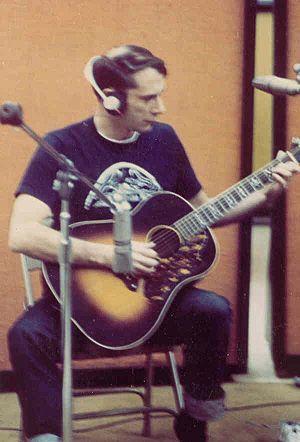
American primitive guitar is a special kind of fingerstyle. It was started by John Fahey in the late 1950s. This style often uses folk music ideas, a steady alternating bass fingerpicking, and special guitar tunings like open D or open G. It also mixes in sounds from other traditional music styles, like Indian classical music or Japanese Koto.
Country Music Fingerpicking
Fingerpicking became popular with country and western artists like Merle Travis and Chet Atkins. Chet Atkins helped develop the style even further. Today, musicians like Jose Gonzalez and Tommy Emmanuel use this style. Most fingerpickers use acoustic guitars, but some, like Mark Knopfler, use electric guitars.
Ragtime Guitar
Blind Blake was an early master of ragtime guitar in the 1920s and 1930s. In the 1960s, new guitarists started playing piano ragtime tunes on solo guitar. Dave Van Ronk and Stefan Grossman were important in bringing ragtime guitar back.
Carter Family Picking
Carter Family picking is a fingerstyle technique named after Maybelle Carter of the Carter Family. In this style, the melody is played on the low bass strings (like E, A, and D), while the rhythm is strummed on the higher treble strings (G, B, and high E). It's a very distinctive sound in country music.
Travis Picking
Travis picking is named after Merle Travis and was made very popular by Chet Atkins. In this style, the thumb plays an alternating bass pattern, while the index and middle fingers play syncopated (off-beat) melodies. It creates a full, rhythmic sound, almost like two guitars playing at once.
Clawhammer and Frailing
Clawhammer and frailing are mostly banjo techniques, but they are sometimes used on the guitar. In these styles, you use downstrokes with your fingernail for rhythm, and sometimes an up-pick for melody.
Other Acoustic Fingerstyle Styles
UK Folk Baroque
Folk baroque is a unique fingerstyle that came from Britain in the 1960s. It mixed American folk, blues, jazz, and ragtime with traditional British music. Guitarists like Davy Graham, Bert Jansch, and John Renbourn were pioneers. They often used a special tuning called D–A–D–G–A–D, which gave their music a unique sound. This style was great for accompanying folk songs and creating complex melodies.
"New Age" Approach
In the 1970s, a new style of fingerstyle emerged, often called "New Age." Artists like William Ackerman played original songs on steel string guitars. This music often featured flowing arpeggios (broken chords) and gentle, expressive sounds, different from the bluesy styles before it. It became popular for its peaceful and relaxing feel.
Percussive Fingerstyle
"Percussive fingerstyle" is a style where guitarists hit the strings and the body of the guitar to create drum-like sounds. They also use techniques like string slapping, tapping, and harmonics. Michael Hedges and Eric Roche were pioneers of this style in the 1980s and 90s. Today, artists like Andy Mckee and Jon Gomm are famous for their amazing percussive playing.
Funky Fingerstyle
"Funky fingerstyle" started in the mid-2000s. It's about making one guitar sound like a whole funk or R&B band. Guitarists use special pickups and effects to create bass drum, snare, bass, and guitar sounds all at once. Adam Rafferty even uses "human beat box" sounds while playing!
African Fingerstyle
The guitar came to Africa through traders and missionaries. African fingerstyle often uses techniques from other traditional African instruments like the kora. Jean Bosco Mwenda from Congo was a very important pioneer of African fingerstyle. His music was complex and influential. Other famous African fingerstyle guitarists include Ali Farka Toure from Mali and Tony Cox from Zimbabwe.
Slide, Steel, and Slack-Key Guitar
When playing with a slide or steel guitar, you can't press the strings down on the frets. So, fingerstyle becomes very important because you need to pluck individual strings instead of strumming.
Slide Guitar
Slide guitar is a technique where you use a smooth object (like a glass or metal tube called a "slide") on your finger. You slide it along the strings to change the pitch smoothly, creating a unique, singing sound. This is often done with fingerstyle plucking.
Slack-Key Guitar
Slack-key guitar is a fingerpicked style that started in Hawaii. The name "slack-key" comes from the Hawaiian kī hō‘alu, which means "loosen the tuning key." This is because slack-key guitar is almost always played in special "open" or "altered" tunings. The basic style is like mainland folk fingerstyle: the thumb plays a bass pattern, and the fingers play the melody on the higher strings. Famous slack-key players include Gabby Pahinui and Keola Beamer.
Electric Guitar Fingerstyle
Fingerstyle Jazz Guitar
In jazz, solo guitarists often play in a "chord-melody" style, where they play chords and the melody at the same time. Fingerstyle is great for this. Early jazz guitarists like Eddie Lang and Lonnie Johnson used fingerstyle. Later, George Van Eps and Wes Montgomery became famous for their fingerstyle jazz playing. Wes Montgomery was known for using the fleshy part of his thumb to play bass lines.
Chet Atkins also sometimes used his amazing fingerstyle technique to play jazz songs. Modern players like Tommy Emmanuel continue this tradition.
Electric Blues and Rock
While less common, some electric guitarists use fingerstyle. Slide guitarists like Duane Allman and Ry Cooder often use fingerstyle on electric guitar. Many blues guitarists, including John Lee Hooker and Muddy Waters, also played fingerstyle.
In rock music, artists like Mark Knopfler (from Dire Straits), Jeff Beck, Lindsey Buckingham (from Fleetwood Mac), and Mike Oldfield are known for their fingerstyle playing.
Images for kids
See also
 In Spanish: Fingerpicking para niños
In Spanish: Fingerpicking para niños


